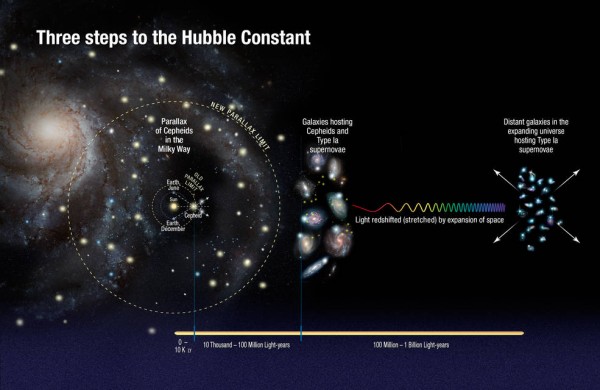Universe is Expanding at 9% Faster Than Previously Thought
| Ana Verayo | | Jun 03, 2016 07:27 AM EDT |
(Photo : NASA, ESA, A. Feild (STScI), and A. Riess (STScI/JHU)) This illustration shows the three steps astronomers used to measure the universe's expansion rate to an unprecedented accuracy, reducing the total uncertainty to 2.4 percent.
Scientists now say that the universe is expanding more rapidly than ever predicted, which is due to a "discrepancy" involving galactic distances among estimates of the early universe after the Big Bang event and more modern and accurate measurements obtained from more advanced instruments.
Like Us on Facebook
For this recent measurement, astronomers utilized NASA's Hubble Space Telescope in order to measure the distance of 19 galaxies between each other with the most accurate results ever produced. These numbers now suggest that the universe is expanding at a rate that is five to nine percent faster than previous rates that are measured from the infant universe.
In this new study, scientists believe that this crucial difference in measurements could offer more clues about how dark matter work in the universe.
According to Adam Riess from the Space Telescope Science Institute and Johns Hopkins University, this is a surprising finding that can lead to an important clue in those cosmic forces that are invisible or do not emit light, like dark matter, dark energy and dark radiation, which makes up 95 percent of the entire universe, which could also explain how the universe expands.
This is now the most accurate calculation yet about the universe's current expansion, which is known as the Hubble constant, possessing a margin of error of only a mere 2.4 percent.
These new calculations are expected to provide a pivotal connection between observations and calculations based on the Big Bang afterglow that have been consolidated by the NASA's Wilkinson Microwave Anisotropy Probe and the European Space Agency's Planck satellite.
Reiss explains that what began from two ends, that are expected to meet in the middle, based from presumably correct calculations and measurements, but now, this new finding is comparable to these two ends not meeting in the middle, and this is where the dilemma begins.
To date, astronomers are now going over their data in order to reduce this margin of error to less than two percent, which could end up with two disagreeable Hubble constants.
Tagsuniverse expansion, universe expanding faster, Hubble Space Telescope, NASA
©2015 Chinatopix All rights reserved. Do not reproduce without permission
EDITOR'S PICKS
-

Did the Trump administration just announce plans for a trade war with ‘hostile’ China and Russia?
-

US Senate passes Taiwan travel bill slammed by China
-

As Yan Sihong’s family grieves, here are other Chinese students who went missing abroad. Some have never been found
-

Beijing blasts Western critics who ‘smear China’ with the term sharp power
-

China Envoy Seeks to Defuse Tensions With U.S. as a Trade War Brews
-

Singapore's Deputy PM Provides Bitcoin Vote of Confidence Amid China's Blanket Bans
-

China warns investors over risks in overseas virtual currency trading
-

Chinese government most trustworthy: survey
-

Kashima Antlers On Course For Back-To-Back Titles
MOST POPULAR
LATEST NEWS
Zhou Yongkang: China's Former Security Chief Sentenced to Life in Prison

China's former Chief of the Ministry of Public Security, Zhou Yongkang, has been given a life sentence after he was found guilty of abusing his office, bribery and deliberately ... Full Article
TRENDING STORY

China Pork Prices Expected to Stabilize As The Supplies Recover

Elephone P9000 Smartphone is now on Sale on Amazon India

There's a Big Chance Cliffhangers Won't Still Be Resolved When Grey's Anatomy Season 13 Returns

Supreme Court Ruled on Samsung vs Apple Dispute for Patent Infringement

Microsoft Surface Pro 5 Rumors and Release Date: What is the Latest?










